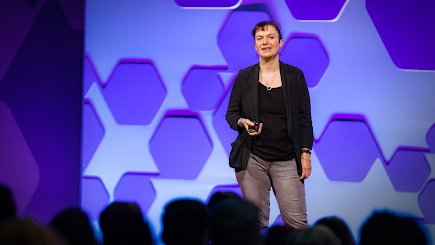 |
| Tiffany Smith - Ted Talk - The history of human emotions |
As human beings, we have the power to communicate using words that make up languages created by us to describe countless things, including emotions. Our history and the history of linguistics are deeply intertwined and influenced by our emotions, even though many of us can't precisely describe what an emotion is. Tiffany Smith, a cultural historian and writer of The Book of Human Emotions, brings up in her TED Talk several aspects of our emotional history and background that are essential to understanding the development of linguistics and, in parallel, our cultural growth and identity.
First and foremost, emotions weren't even a concept before around 1830. This consciousness of the word "emotion," as the author describes in her book, turns out to be fairly recent. In her TED Talk, Tiffany starts by pinpointing that emotions, as much as they seem vague or volatile, are hard to describe and understand, enhancing the difficulty of developing emotional intelligence.
As the human race evolved, we stretched our languages to create new words describing specific feelings often related to cultural experiences or specific events. For example, the Papua New Guinean word Awumbuk describes the feeling of relief after a house guest leaves. These concepts, created around very specific emotions, had power in cultural practices. Following the example given earlier, the New Guineans would fill a bowl with water after guests left and perform a ritual the next morning, throwing the water out to dispose of the emotional residue caused by that person.
In a way, we can admit that culturally, we have the power to name and categorize emotions and ritually end them. This suggests that our range of emotions is very wide and complex. However, some scientists simplify our emotional existence by following the 2000-year-old idea that there is a handful of basic human emotions (measured by comparing reactions to some emotions and taking them as universal) like happiness, sadness, fear, excitement, disgust, and anger, which form our emotional persona's building blocks. This concept was demystified by the neuroscientist Lisa Feldman Barrett, who states in her book How Emotions are Made, in the section "The Search for Emotion's Fingerprints," that "variation is the norm" and "emotion fingerprints are a myth".
Specific words embody sensations like Amae - a Japanese word to describe the relief of passing your life's responsibilities to someone else. Tiffany clarifies that emotions are a cognitive phenomenon rather than reflexes coming from our experience; emotions, therefore, are as cultural as the words invented to describe them. As Tiffany said, "there's a historicity in emotions," and to understand them, we should move forward into unveiling how these words came about and why they were created.
Retelling the story this author told the audience, the word Nostalgia (nostos - home and Algia - longing/pain) now describes a feeling of missing a time rather than a place. However, it was originally defined in 1688 as the name of a disease describing a severe pathological case of homesickness, in this case, considered lethal. Of course, nowadays, no one considers this a serious issue. The historian's explanation makes sense: as time changes, our mentality evolves, as well as technology, medicine, art, and culture, frequently upgrading or downgrading several emotions as they no longer affect us as they did in the past. Today we celebrate happiness, but in the 16th century, sadness was cultivated as a skill to make people more resilient. In modern times, we have all sorts of motivational support and a whole system designed to help us reach our goals.
With this information in mind, we can conclude that emotion is becoming even more complex, and simple words like "anger" no longer describe all sorts of emotions. As Barrett states in the same book mentioned before - "If we want to truly understand emotions, we must start taking that variation seriously. We must consider that an emotion word, like 'anger,' does not refer to a specific response with a unique physical fingerprint but to a group of highly variable instances that are tied to specific situations." This opens new doors to more cultural emotion-related word variations. Just as the technological revolution possibly reduced our suffering from nostalgia, it will also allow us to feel different things and name them according to the predicament at the time.
An example of this is the word "Boredom," first created by the Victorians in response to a feeling of weariness and disgust. Citing Tiffany in her book: "When the new emotional category of 'boredom' – from the French bourrer (to stuff or satiate; literally, to be fed up) – first appeared in the English language in 1853, it was a consequence of a rapidly changing relationship to time. Pre-industrial societies had not distinguished between work and domestic drudgery, but the rapid expansion of factories and offices in cities from the late eighteenth century produced a new way of dividing up the day, inaugurating the concept of 'leisure time'." "In this context, finding oneself at a loose end or trapped in dreary company, or feeling unable to be interested, attentive or useful, was a mark of inadequacy. Doctors debated boredom's unsavoury health implications (alcoholism, onanism, excessive sleeping). Politicians vilified it as a social ill and blamed the poor and unemployed for allowing it to fester. Feminist campaigners and novelists pointed out the emotion's corrosive effects on middle- and upper-class women."
In conclusion, knowledge of emotions and their intriguing, exotic words is a valuable commodity to understand generations, centuries, and even grasp history throughout time. Emotions tell us about the world around us, contribute to bringing significance into real-life predicaments, present themselves as important clues for everything happening in our time, and, last but not least, allow language to evolve, enriching cultural significances. Tiffany Smith's TED talk highlights the importance of this emotional literacy, reminding us that our understanding of emotions is not static but continually evolving with our culture and language.